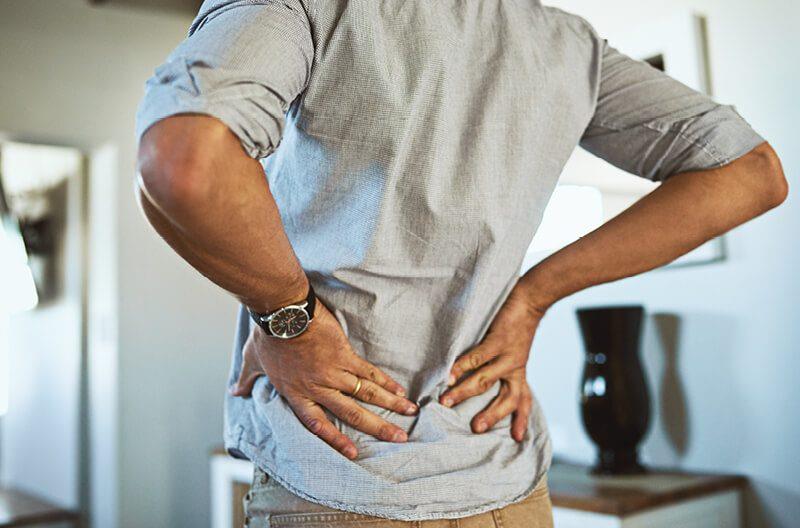- Home
- Mind & body
- Managing lower back pain
At CBHS we help you manage your health challenges. We believe in offering you the services, support and tools you need to live your best life.
Our Better Living Programs are available to support eligible members towards a healthier lifestyle. Each Better Living Program is subject to its own eligibility criteria.
Contact us for more information and to confirm your eligibility for a program.
Managing lower back pain

Understanding lower back pain
According to the Australian Bureau of Statistics, four million Australians had back problems in 2017-2018 and it’s estimated that 70 to 90% of us will experience lower back pain at some point in our lives.
Lower back pain is generally felt as stiffness, tension and soreness in the lower back area. It can also be felt in the neck, shoulders and thighs. It usually resolves in a few weeks or months.
Lower back pain that lasts less than three months is known as acute lower back pain. Lower back pain that lasts longer than three months is known as chronic lower back pain.
Causes of lower back pain
Lower back pain is a leading cause of disability in Australia with one in seven Australians experiencing it on any given day.
The condition often occurs as a result of a repetitive load injury rather than a single event. Where no specific cause is identifiable, it may be referred to as non-specific lower back pain.
You can read more about the causes of back pain and risk factors for developing back pain at Healthdirect Australia.
Managing lower back pain
Stay active
When you’re experiencing back pain, you may feel like lying in bed and getting some rest, but staying active is actually the best thing you can do. Prolonged bed rest may actually slow your recovery.
Find a comfortable sitting position
If you have lower back pain, it’s best not to sit in the same position for too long. MyBackPain recommend finding a support for your lower back like a towel or cushion. If you sit at a desk, it’s a good idea to set a timer to remind you to get up and move around at regular intervals. You may also find standing desks helpful.
Try some lower back exercises
Exercises may help to improve your flexibility and strength and ease some of the pain. You can try lower back pain exercises from the National Health Service UK.
Activities to avoid
If you have lower back pain, you should try to avoid the following activities as they could make the pain worse:
- lifting heavy objects
- driving for long periods
- sitting in the same position for long periods
- crossing your legs at your desk
Pain medications
Your doctor may recommend taking medication, such as anti-inflammatory pain relief which includes Ibuprofen and Diclofenac. The goal of medications like these are to reduce the pain to a level where you are able to function and remain active. You can find out more about this from NPS Medicinewise.
When to see a health professional
Most people who experience back pain don’t need to see a health professional as it will resolve in a week or two. According to MyBackPain, you should see a health professional if your lower back pain is any of the following:
- severe
- getting worse
- causing you worry
- stopping you from going to work or school
Types of health professionals
There are several types of health professionals that may be able to help you with your back pain. MyBackPain has useful information on each including what they do, how to find one, and how to prepare for your visit.
Diagnostic tests
Imaging tests can include MRI’s, X-rays, and CT scans. The Royal Australian and New Zealand College of Radiologists recommends health professionals don’t send people with acute lower back pain to get imaging tests if there are no signs of a serious cause for the pain. This is because imaging tests come with risks including exposure to radiation, are often very expensive, and often can’t show the cause of the pain.
Getting help online
MyBackPain is a resource that has been developed by Arthritis Australia, Queensland University and the Cochrane Back and Neck Group. It provides trustworthy and up-to-date information on managing lower back pain.
Sources:
http://www.choosingwisely.org.au/recommendations/ranzcr
https://mybackpain.org.au/about
https://www.healthdirect.gov.au/back-pain-self-care
https://www.healthdirect.gov.au/back-pain
https://www.healthdirect.gov.au/what-causes-back-pain
https://www.healthdirect.gov.au/back-pain-symptoms
https://www.nhs.uk/conditions/back-pain/
https://www.nhs.uk/live-well/exercise/lower-back-pain-exercises/
https://arthritisaustralia.com.au/what-is-arthritis/areas-of-the-body/back/
https://www.betterhealth.vic.gov.au/health/conditionsandtreatments/Back-pain
Health and wellbeing
programs & support
You Belong to More with CBHS Hospital cover:
- Greater choice over your health options including who treats you
- Get care at home with Hospital Substitute Treatment program
- Free health and wellbeing programs to support your health challenges
Live your healthiest, happiest life with CBHS Extras cover:
- Benefits for proactive health checks e.g. bone density tests, eye screenings
- Keep up your care with telehealth and digital options
- Save on dental and optical with CBHS Choice Network providers
